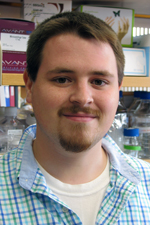GDSC Graduate Student Brandon Park Passes his Qualifying Exam!
Thursday, August 26, 2021
 Completing his 2nd year on a high note, GDSC Graduate Student Brandon Park, passed his Qualifying Exam. Brandon plans to focus his research on Nucleic Acid Biology, Epigenetics, and Development. His thesis proposal is titled “Using New Technologies to Investigate the Role of H2A.Z in Epigenetic Inheritance”. Brandon is pursuing his doctoral research under a co-mentorship with Dr. Mitch O’Connell, and Dr. Patrick J. Murphy.
Completing his 2nd year on a high note, GDSC Graduate Student Brandon Park, passed his Qualifying Exam. Brandon plans to focus his research on Nucleic Acid Biology, Epigenetics, and Development. His thesis proposal is titled “Using New Technologies to Investigate the Role of H2A.Z in Epigenetic Inheritance”. Brandon is pursuing his doctoral research under a co-mentorship with Dr. Mitch O’Connell, and Dr. Patrick J. Murphy.
Congratulations Brandon!
Brandon Park’s thesis proposal may be read below.
Abstract: 5-methylcytosine (5mC) is a major form of DNA methylation that is often observed at the promoters and enhancers of repressed genes, but the mechanisms by which 5mC patterns are maintained in developing primordial germ cells (PGCs)is currently unknown. Nucleosomes that contain the histone variant H2A.Z function as “placeholders” in early embryos to deter DNA methylation following fertilization, and are thus located at hypomethylated regions, such as promoters for genes involved in early development. Therefore, I hypothesize that H2A.Z maintains this function during PGC development, allowing the DNA methylation patterns of stem cells to be maintained in PGCs. This mechanism would facilitate the trans-generational maintenance of 5mC patterns and might enable adaptive evolution if changes to these 5mC patterns are inherited. To date, technical limitations of Chromatin Immuno-Precipitation (ChIP) have made it difficult to assess the localization of chromatin modifications throughout PGC development and in mature oocytes. CUT&TAG is a recently developed alternative to ChIP-Seq that provides significantly improved signal to noise and can be done on just a few thousand cells. For this reason, I will use CUT&TAG to investigateH2A.Zpatterns in PGCs that have been purified via Fluorescence Assisted Cell Sorting (FACS), as well as whole WT sperm, oocytes, and early embryos. I will bioinformatically analyze the resulting H2A.Z landscapes to define regions where H2A.Z patterns change or are maintained in different cell types. These experiments will create a reference point for defining H2A.Z landscapes, and test our hypothesis that H2A.Z patterns are maintained throughout germ cell development. Functional studies of PGCs have also been limited by the availability of genetic tools in zebrafish, as well as difficulties generating tissue specific knockdown effects. Here I will create a tissue-specific CRISPR system to knockdown H2A.Zat various time points during PGC development using a heat shock inducible promoter to control gRNA expression. I will investigate the effects of these knockdowns by doing CUT&TAG for H2A.Z, locus specific bisulfite sequencing (through PCR), and monitoring for phenotypic changes in the mature germ cells and next generation embryos. Together, these experiments will combine CRISPR and CUT&TAG methods to establish several epigenomic profiles for various factors involved in regulating gene expression in developing zebrafish embryos and PGCs. These studies will also provide new insight into the role of H2A.Z in 5mCmaintenance and transgenerational epigenetic inheritance.
UR Center for RNA Biology RNA Presentation Contest Results
Tuesday, February 2, 2021
Thank you to those who participated in and/or viewed the UR Center for RNA Biology's RNA Presentations on Jan 6th, 13th, and 27th, sponsored by the RNA Society and Lexogen. The judging committee was impressed with the quality of the presentations given on all three dates, making final decisions difficult.
All nine of the graduate student, postdoc, and technician presenters, chosen based on their quality of their abstract, will be receiving a one-year membership to the RNA Society. Of these, four who were chosen based on the quality of their presentation will be awarded $375 each to be used toward the attendance of an RNA-centric meeting, in person or virtually.
The four to be awarded a one-year membership in the RNA Society and $375, in alphabetical order, are:
Kamel Awayda (presented Jan 6th )
Technician, Mitch O'Connell Lab
"Characterization of THUMP Domain-Containing Protein 1, and Putative Modulator of RNA Modification"
Chen Bao (presented Jan 13th)
Biochemistry Grad Student, Dmitri Ermolenko Lab
"mRNA Stem-Loops Can Induce Translational Pause through Two Pathways"
Xavier Rambout, PhD (presented Jan 27th)
Postdoc, Lynne Maquat Lab
"Transcriptional Coactivator PGC-1α Contains a Novel CBP80-Binding Motif that Orchestrates Efficient Target-Gene Expression"
Arica VanderWal (presented Jan 13th)
Biochemistry Grad Student, Mitch O'Connell Lab
"The Role of Csx28 in CRISPR-Cas13b Anti-Bacteriophage Defense"
The remaining to be awarded a one-year membership in the RNA Society, in alphabetical order, are:
Lily Cisco (presented Jan 6th )
Pharm-Phys Grad Student, John Lueck Lab
"Testing Therapeutic Intervention for Myotonic Dystrophy Type 1 in a Novel Mouse Model"
Xueyang He (presented Jan 6th )
Biophysics Grad Student, Paul Boutz Lab
"A Novel Method to Capture and Sequence Intron Lariats"
Shon Koren (presented Jan 6th )
Technician, Gail Johnson Lab
"Tau-Ribosome-tRNA Associations Underlie Common Features of Dys sincening Protein Synthesis in Dementia"
Sean Lindley (presented Jan 13th )
Biology Grad Student, Doug Anderson Lab
"StitchR: Ribozyme-Mediated RNA Trans-Splicing and Expression in Mammalian Cells"
Debanjana Maji (presented Jan 27th )
Biophysics Grad Student, Clara Kielkopf Lab
"Representative Cancer-Relevant U2AF2 Mutations Alter RNA Interactions and Splicing"